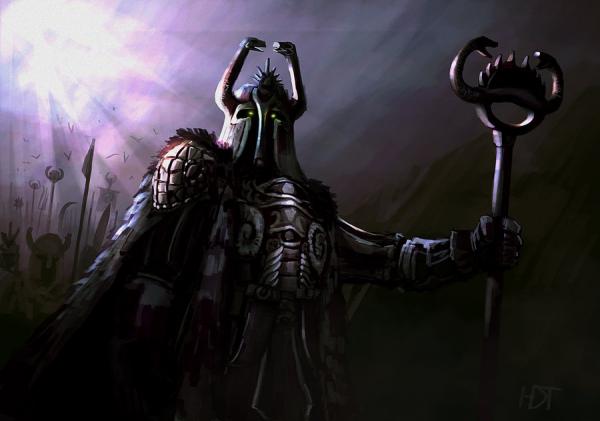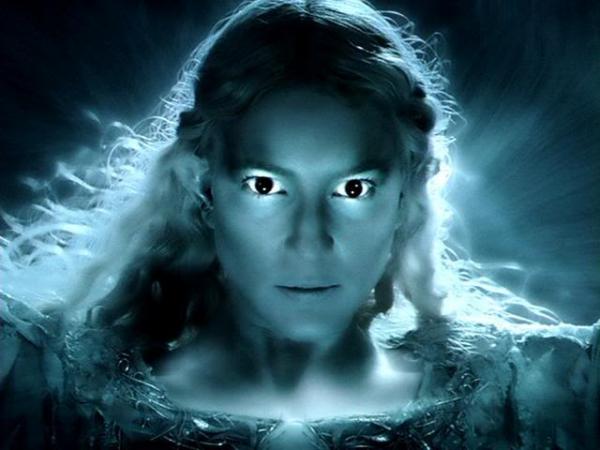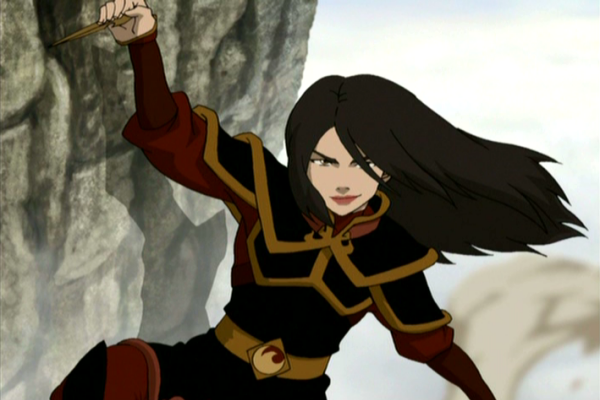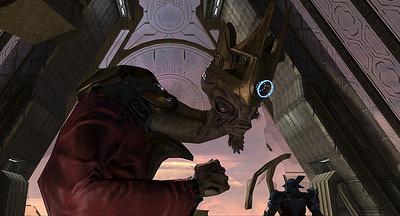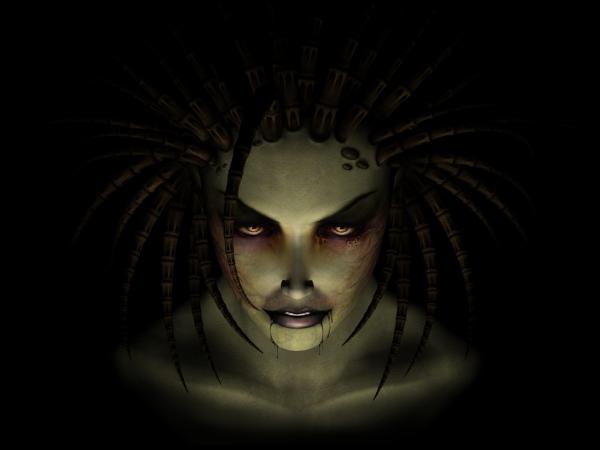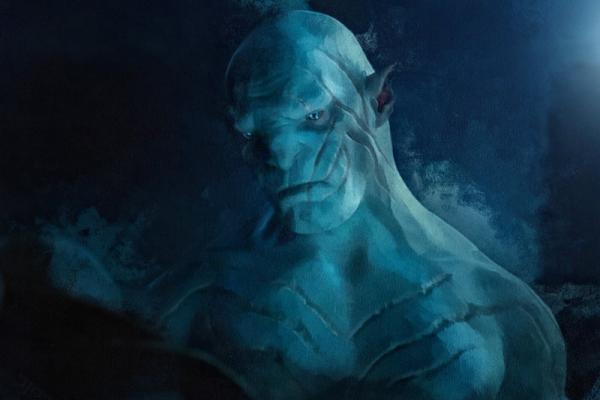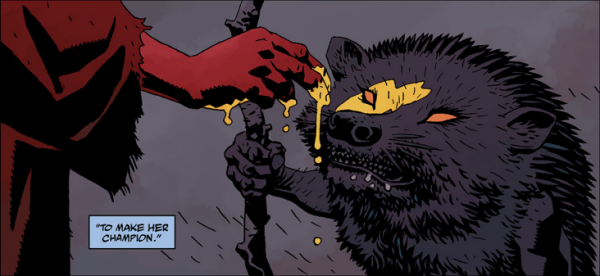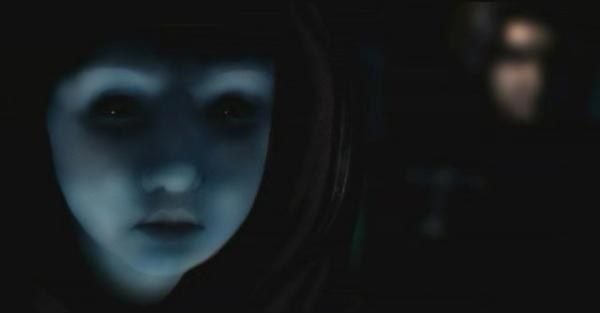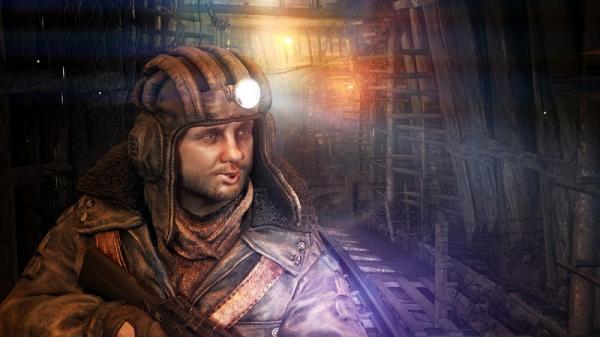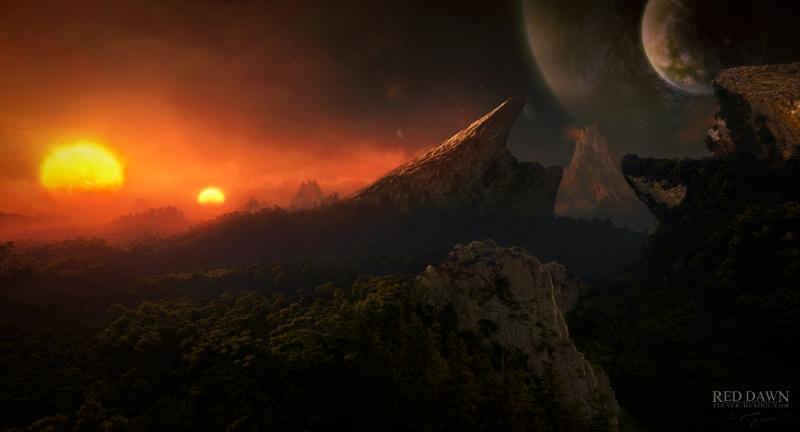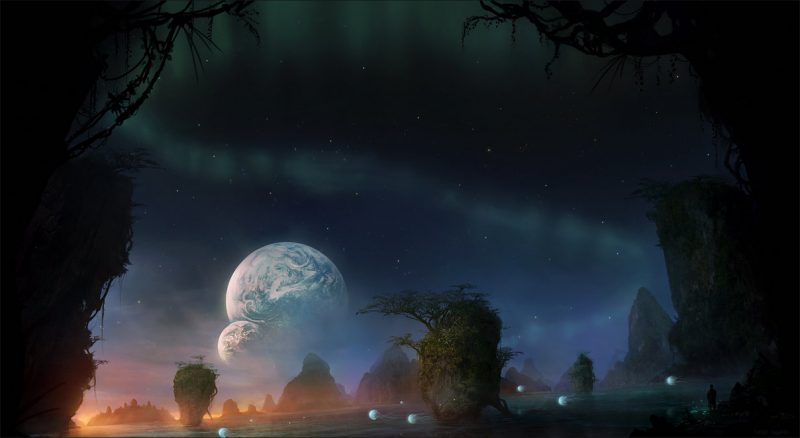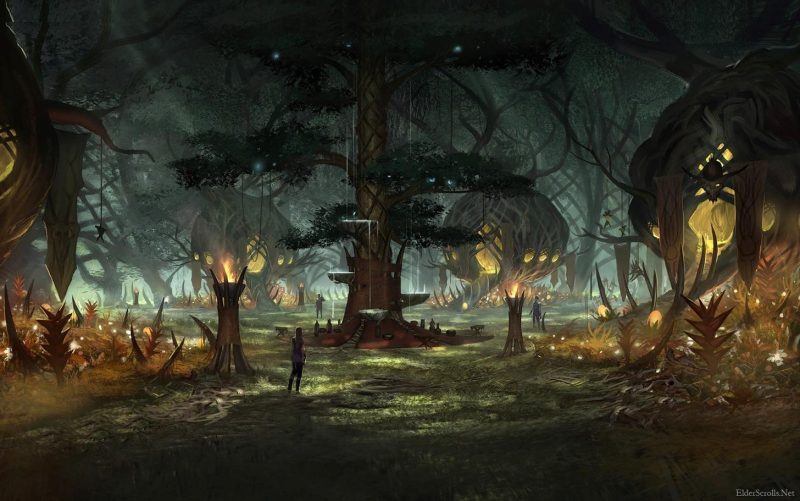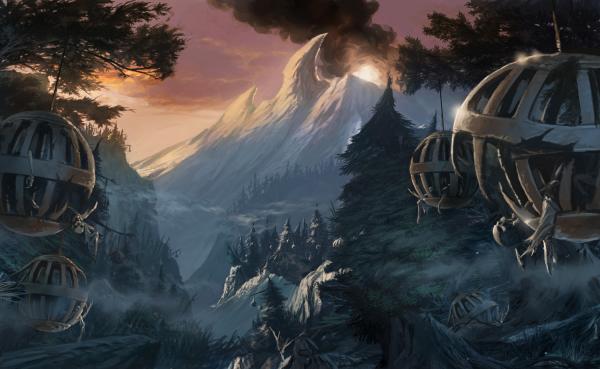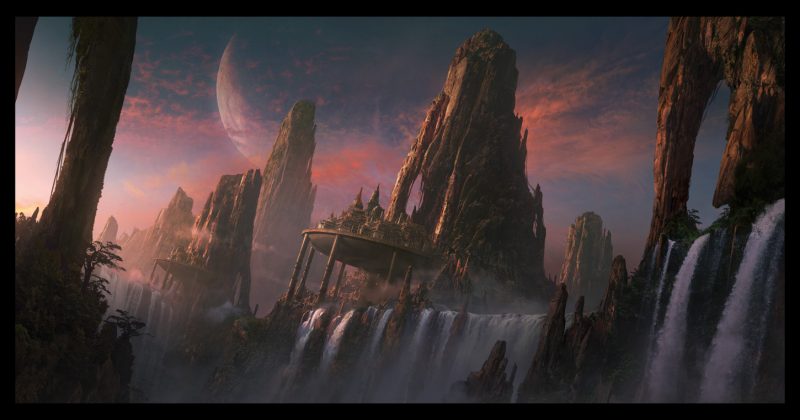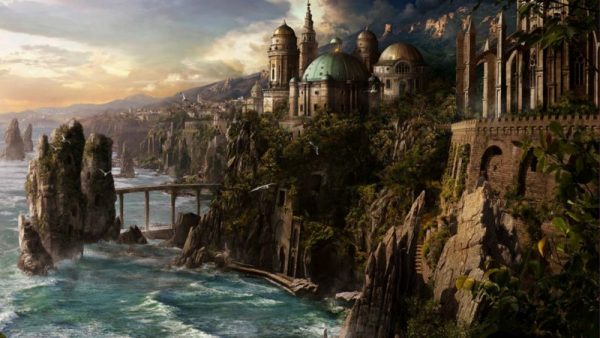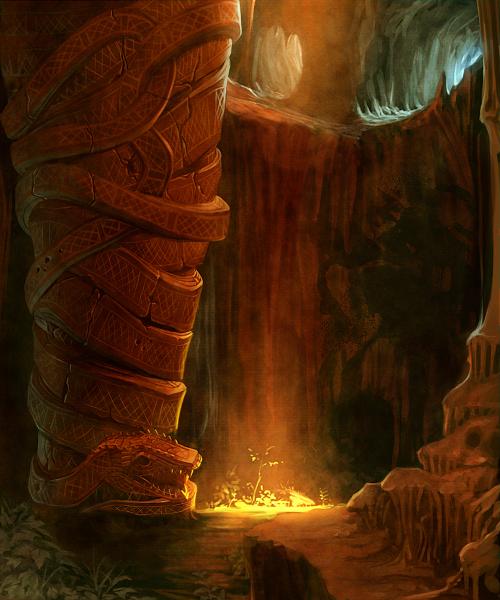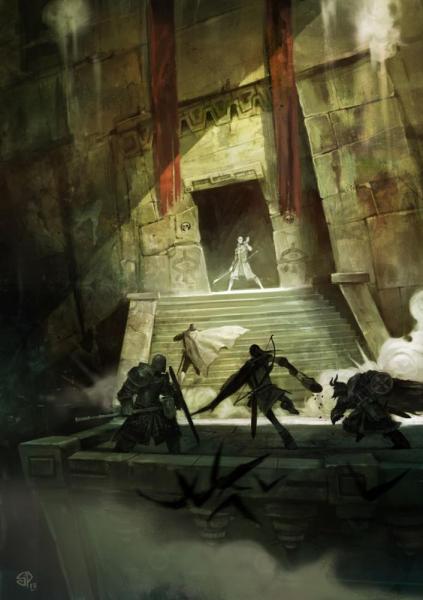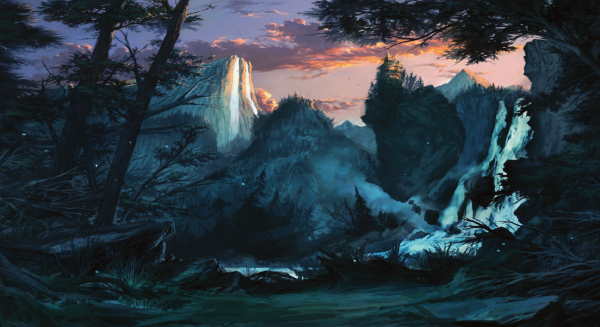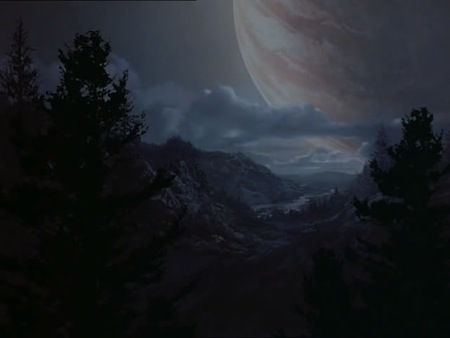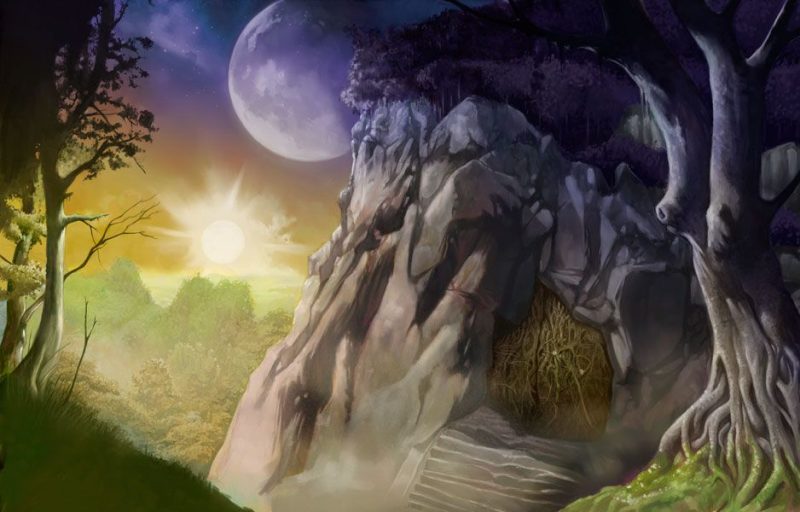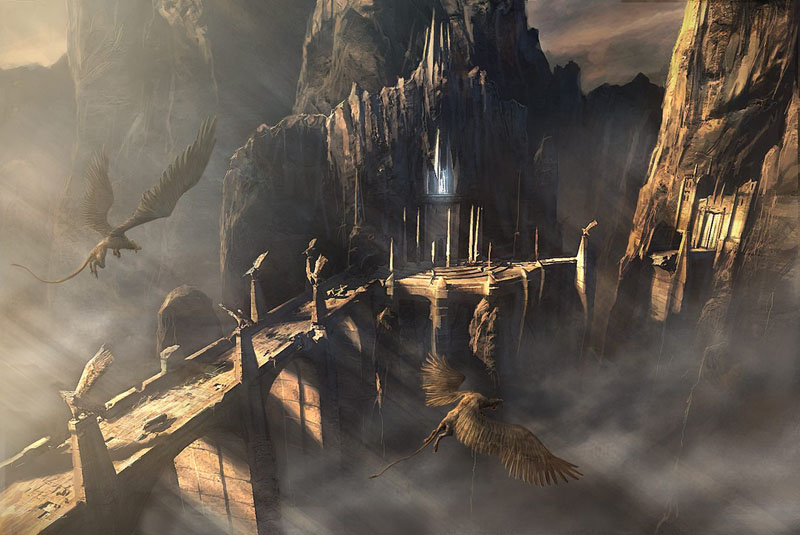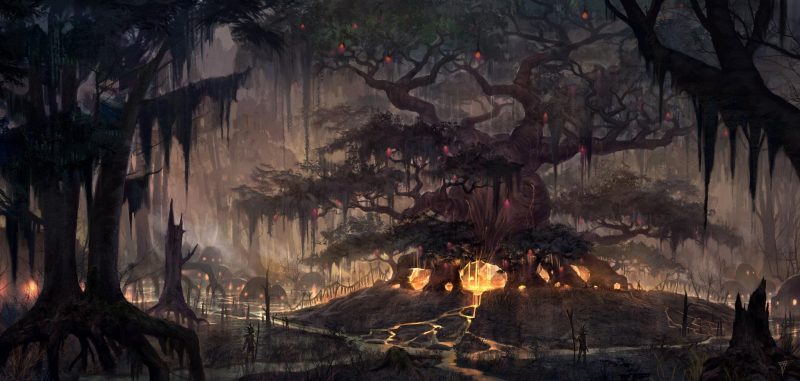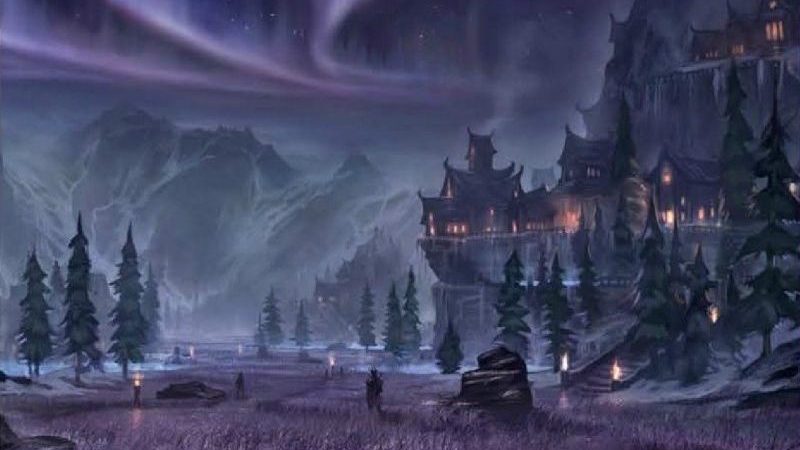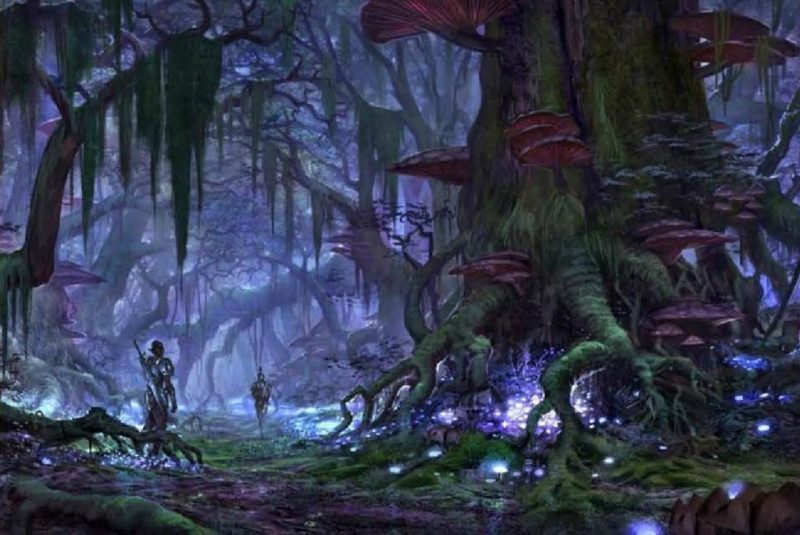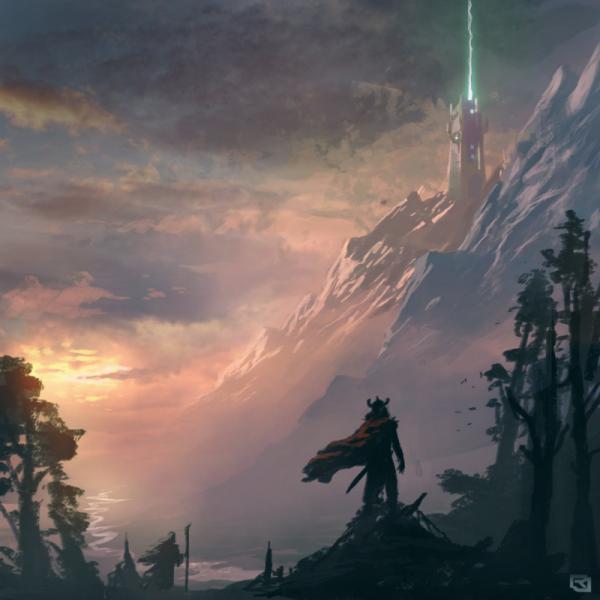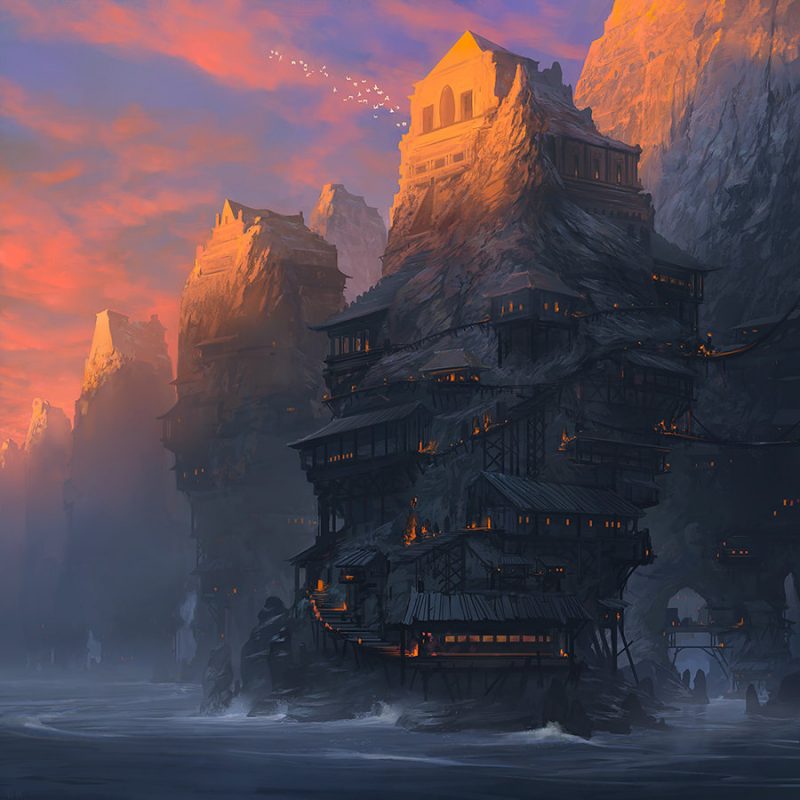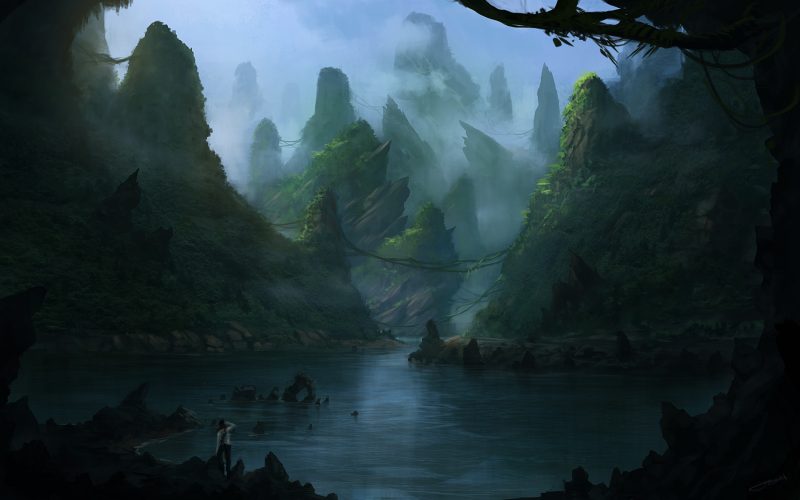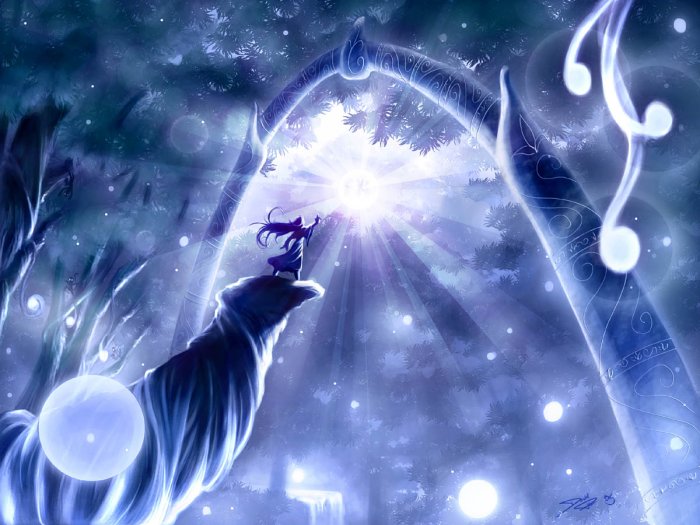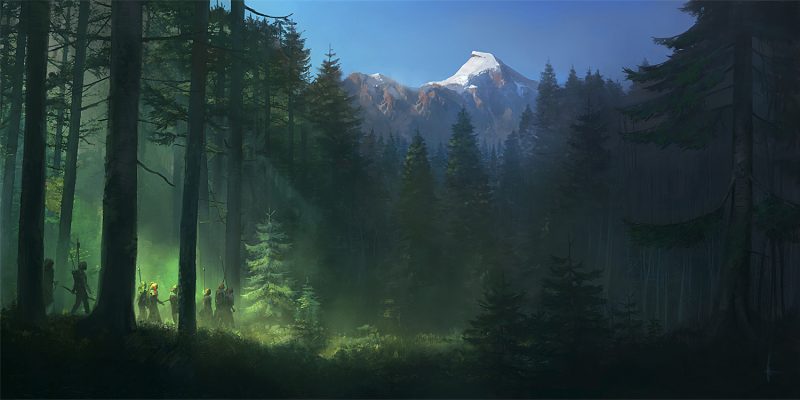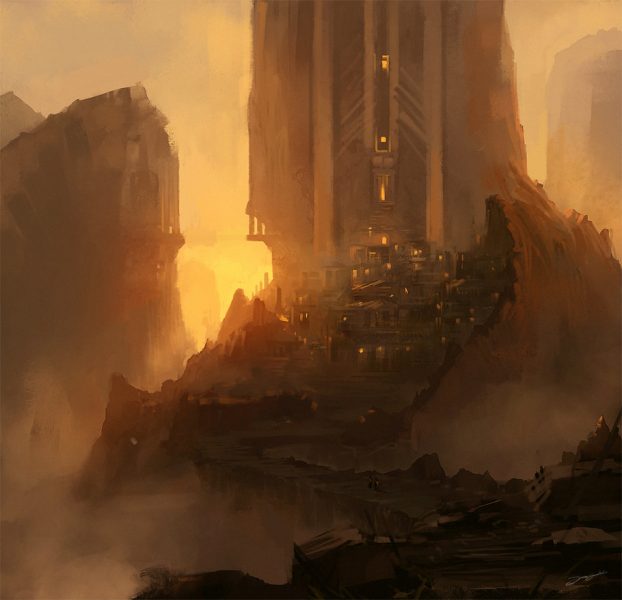Almost a year ago, I made up a list of great villains from fiction that I want to use as direct inspirations for my own antagonists. Even though this setting is very different in style and tone, I found that this list is still representing my top picks for great antagonists to emulate. They need to be human in their desires and limitations and failings, but also absolutely dispicable. This is what great enemies look like.
Tag: Retro Kaendor
Impressions of the Eldritch Wilds
Calendar of the Ancient Lands
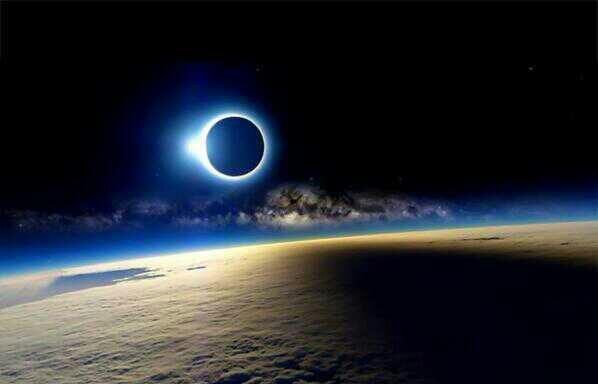
Yesterday I wrote about the gas dwarf companion of the forest planet on which the Ancient Lands are located. Today I am adding to that with the calendar that people of the region use to track time based on those astronomical observations. Since the gas dwarf is such a huge presence in sky and months are relatively short, the sun has relatively little symbolic significance in the setting so far, and the main use of the calendar is to track the phases of the moon, I am going with a lunar calendar instead of a solar calendar. Lunar calendars are a bit more complicated to use for long term record keeping than solar calendars, but as this is pretty much not a factor for the Ancient Lands, a lunar calendar is much more convenient.
- A month has 16 days and begins on the first sunset after the new moon.
- Nights of the full moon always fall on the night after the 8th day of the month.
- A solar year has 381 days from one winter solstice to the next winter solstice.
- A calendar year has 384 days, and each new year begins on the first sunset after the first new moon since the winter solstice.
- Because the solar year is three days shorter than the calendar year, every 16th calendar year has only 23 months and ends on the day of the winter solstice.
- In reality there would have to be occasional leap days as orbits are never perfectly synchronized in nature, but since for the purposes of an RPG time is measured in month and not in centuries, these are simply ignored for convenience.
In addition, solar eclipses are fairly regular things.
- Solar eclipses only happen during new moons, so they always fall on the last day of the month (the 16th).
- Because of axial tilt, eclipses only happen during spring and fall, never in summer or winter. This means the 4th to 7th and the 16th to 19th month.
- This means the possible dates for a solar eclipse are 16.04., 16.05., 16.06., 16.07., and 16.16., 16.17., 16.18., 16.19. There is a 50% chance that it happens during daytime for any place in the world.
- Since the apparent diameter of the gas dwarf is 8 times greater than that of the sun, eclipses will almost always be total. They last between 10 and 30 minutes (1d3 turns).
That’s no Moon
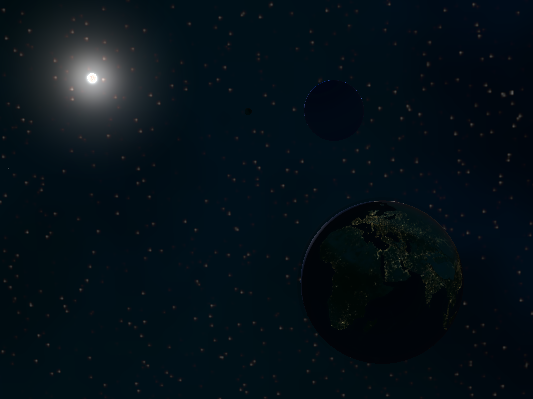
It’s a gas dwarf.
I never made any secrets about how much I love the worldbuilding of Morrowind. (It’s gameplay is a different matter.) And I never let an opportunity pass by to tell everyone how much I love Star Wars. I also liked the world of the old videogame Albion and the whole old Planetary Romance genre in general. When I wrote down my Project Forest Moon concept paper to spice up the Ancient Lands with more mythic and puply atmosphere, that title was just a name referencing the visual style of Endor in The Return of the Jedi. But that phrase stuck with me until I recently decided to have the Ancient Lands be set on an actual moon. I know a fair bit about astronomy and while I think scientific accuracy is vastly overrated in fantasy worldbuilding, I think no creator likes to create stuff they know to be wrong within the rules of their fictional world. So I sat down to figure out a configuration that is at least somewhat plausible if you’re not getting too specific about the exact numbers involved. Or in other words, I feel pretty confident that planets like this can exist if you just find the right numbers for masses and distances to keep everything in semi-stable balance.
Having an Earth-sized moon orbiting a gas giant (like the Rebel base on Yavin 4 in Star Wars) would have all kinds of “interesting” effects that would make any kind of Earth-like environment on it vastly implausible. And you’d also end up with all kinds of funkiness regarding day length and daily solar eclipses lasting for hours. To keep things much simpler and more familiar, I chose to make the big ball in the sky a gas dwarf instead.
So what is a gas dwarf?
Gas dwarves are the most recently discovered type of planet that exists in other star system, which look very much like gas giants but are much smaller than those. In their center is a solid rocky core like a common terrestial planet which is then surrounded by a massive atmosphere of hydrogen and helium. Planets like Earth or Venus have not enough gravity to hold on to these very light gases in significant quantities, but if you go just a little bigger in size gravity is strong enough to keep these huge balls of gas together. The total mass of gas dwarves is between 1.7 and 4 times the mass of the Earth and it appears that they are one of the most common types of planets in the universe. It’s just a random oddity of the solar system that we ended up not having any of these. Being so much smaller than a gas giant the gravitational effects and its magnetic field would be much smaller than what you have in a behemoth like Jupiter or even Neptune.
I recently got myself Universe Sandbox 2, which I’ve been fascinated about for a very long time, and made a quick simulation of what it might look like if you take Earth and switch the Moon for smallish gas dwarf. I started by taking Neptune and changing its mass to 2 Earth masses. The program then did the recalculation of it’s actual size automatically. As expected, two bodies of such similar size would actually form a binary planet, both orbiting about a point between them instead of one going around the other, with the world if the Ancient Lands not being actually a moon. But it’s close enough. The screenshot at the top of this post is taken directly from the simulation I made with everything being at actual scale, with the gas giant being the same distance away from Earth as the Moon. But it’s a lot bigger and the little black dot next to the bigger blue ball is what the Moon would look like from this perspective. At 8.5 times the radius of the moon the gas dwarf would take up an area in the sky 72 times bigger. Hydrogen clouds would also reflect light much better than moon rocks, so the light of a full moon would likely be hundreds of times brighter than what we get here on Earth. However, human eyes are actually really amazing at automatically adjusting to light levels to give the brain the appearance that everything is normally lit. We did measurements of light levels in greenhouses in school and rooms that seem to be evenly lit actually get several times the amount of light close the sun facing windows than at the opposite side. Sunlight is obviously brighter than the light of a full moon, but human eyes adjust so well that you probably wouldn not have suspected that it is actually 400.000 times brighter. So even with a full moon being 400 times brighter than on Earth, the nights wouldn’t actually look much brighter to the eyes of people.
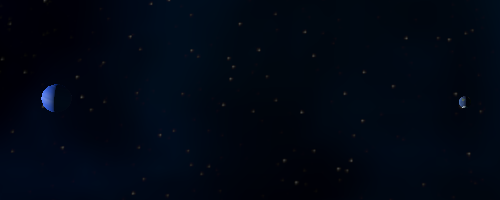
This is the Earth and the gas dwarf seen side on at actual scale. This shows the actual relative sizes and distances of the two bodies.
Tidal effects would obviously be much more severe as those caused by the Moon. However in practice, the actual rise and fall of the water is influenced much more significantly by the shape of coastlines than the gravitational pull of the moon. While there would be some bays experiencing absolutely astonishing tides, it should not be too dramatic for most coasts to completely change life near the sea. The time between high tide and low tide remains roughly 6 hours since the day is 24 hours in length. The orbital speed of the gas dwarf is marginal compared to the rotation of the forest planet.
Sadly, one thing that Universe Sandbox can not simulate is tidal locking. Tidal locking is when a smaller body slows down its rotation to the point where it matches its orbit around the larger body, causing it to always show the same side to the larger body, while the larger body would remain stationary in the sky of the smaller one. I think this is boring and want my wandering gas moon, which is why I gave it such a low mass to reduce this effect. In reality, the effects that cause tidal locking are working on every smaller body orbiting a larger one. The only question is how long it will take for the rotation to slow down before a true lock is reached. For the Earth and the Sun, tidal locking actually takes longer to reach than the Sun is going to live. One number I’ve found is that the Earth actually had days of only 6 hours when it first formed. So the fate of my world is sealed and it will eventually tidally lock to the gas dwarf. But the gas dwarf has only twice the mass of the forest planet while in comparison the Earth has 80 times the mass of the Moon. So I see it as completely plausible that a after three billion years the forest planet still has a nice 24 hour day and is a very far way from getting locked and the gas giant keeps moving in the sky.
Another interesting number is the length of a month. That is time from one full moon to the next full moon. In this particular configuration of masses and distances that I uses this turned out to be almost exatly 16 days. That would be 4 days from new moon to half moon and from half moon to full moon, and the same back of course. 16 is a very attractive number, being a square of an even number, so I keep that for the days in a month. For the number of months in a year, 24 would also be a very attractive number, being a multiple of 12. If a month where exactly 16.0 days and a year exactly 24.0 months, it would lead to a year of 384 days. Very close to what we think of when we are talking about “a year” as a unit of time. But such a perfect synchronisation would seem vastly implausible to me, so in the tradition of the Japanese aesthetic of wabi-sabi I am setting the length of the year at roughly 381 days, with the occasional leap day now and then. And sometimes a year happens to have only 15 months. Since I am lazy with such things and calendars show up rarely in practice in campaign, I’m not making any names for months or days of the week. It’s simply the first day of the eleventh month. With each month beginning at the new moon.
Another cool subject is solar eclipses. Because with a diameter 8 times larger than the Moon, the gas dwarf has a really easy time completely covering up the sun. In reality the Moon passes between the Earth and the Sun once every month during the new moon. However in most months it will pass actually above or below the sun in the sky since all orbits are not perfectly flat. How often you get solar eclipses depends on the tilt of the orbit, the size of the moon compared to the sun, and the length of a month, but they will be most common during spring and fall. There are 16 opportunities for an eclipse every year and a 50% chance for any place on the planet to be on the sun facing side when it happens, resulting in a total maximum of 8 if the orbits where perfectly flat. I really don’t want to worry about the exact math of this, so I am just arbitrarily setting the number of total eclipses a place experiences in a year at 1 or 2. However, I am pretty sure there is an orbital tilt that would lead to this result. I just don’t want to calculate that number as it will never come up in a game. On Earth a solar eclipse can last up to eight minutes. With the gas giant being eight times wider but it going around the planet at double the speed, this gives us eclipses of up to 30 minutes. So to streamline the numbers for practical use, a total eclipse lasts for 10 to 30 minutes.
So that’s the sky and the resulting calendar in the Ancient Lands. I actually tried to simulate each of the two planets having a small moon of their own, adding Deimos and Phobos to the system. When I ran the simulation, the Earth immediately flung its moon on a course to the sun while the gas dwarf threw its moon straight at Earth, leaving a huge crater lake in Morocco. I am pretty sure it should be possible to have two minor moons in the sky as well, but I am not going to include these into the simulation. They are just there in the sky looking pretty and not having any noticable effect on the planet below.
The Ancient Lay of the Land(s)
Last week or so I’ve been writing about how I consider organizing the setting material for the Ancient Lands into individual documents for each region, similar to the FR and GAZ modules for D&D. But thinking more about it I realized that doing 12 of these would be a bit much and one area is actually really small while another is not even intended to be explored like the others. Mentally playing around with possible ways to group some regions together, I came to the conclusion that there are actually four destinct regions whose lands and cultures are strongly interconnected but have few links with the others. Having a total of four regional books that can stand on their own as complete settings containing multiple landscapes and interactions between local groups seems actually much more practical to both write and use. So each book might indeed end up at a scope very similar to FR5 The Savage Frontier.
To get myself back into regularly writing about the actual world itself, here is a shortish post on the four main region of the Ancient Lands that will be described in detail. They still only make up only a relatively small part of the continental map, with probably some 80% being left entirely blank. I’d say they probably hold 80% of the humanoid population and most of the major settlements big enough to end up on a map, but those blank spaces should hold plenty of room to possibly add more regions later. Though at this point I can’t really think of any kind of land I’d like to create that isn’t already incuded.
I don’t have any good map of the continent right now, but basically it’s a crescent shaped coast open to the ocean in the west (I grew up close to the North Sea and in my mind the sun has to set in the sea) with two clusters of islands near the tips. Everything east of coast is forests stretching on forever.
The Northern Forests
Since this region is the closest to the original inspirations for the Ancient Lands I want to cover it first and it will probably be the focus of most of my writing for the forseeable future. There used to be a big long mountain range that marks the northern edge of the map, but I realized that a single region from the coast in the south all the way to the mountains would have to be huge, and it’s actually a stupid cartographic cliche carried over from Middle-Earth and Forgotten Realms.
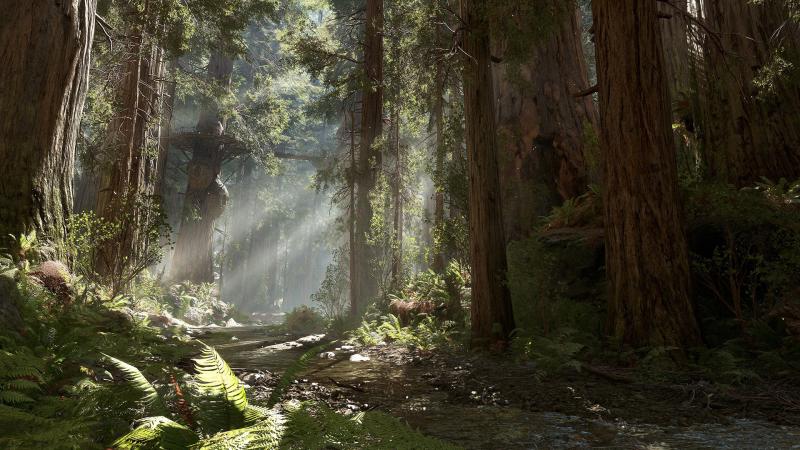 The Northern Forests are the lands that lie on the northeast shore of the Inner Sea and are covered in dense temperate forests. Near the coast the climate is quite mild but a few hundred miles north arctic winds cause more of a subarctic climate dominated by coniferous taiga woodlands. The Northern Forests are the homeland of wood elves and kaas and many of the larger fortress cities of the skeyn. They are also the main region where treants, giants, shie, and dragons rule over the lands and many abandoned and inhabited fey castles can be found.
The Northern Forests are the lands that lie on the northeast shore of the Inner Sea and are covered in dense temperate forests. Near the coast the climate is quite mild but a few hundred miles north arctic winds cause more of a subarctic climate dominated by coniferous taiga woodlands. The Northern Forests are the homeland of wood elves and kaas and many of the larger fortress cities of the skeyn. They are also the main region where treants, giants, shie, and dragons rule over the lands and many abandoned and inhabited fey castles can be found.
The Inner Sea
The southern Inner Sea is the most civilized region of the Ancient Lands where most of the major port cities are located. Which for this setting means something inspired largely by the city-kingdoms of Greek myth or downscaled versions of the late Bronze Age civilizations of the eastern Mediterranean Sea.
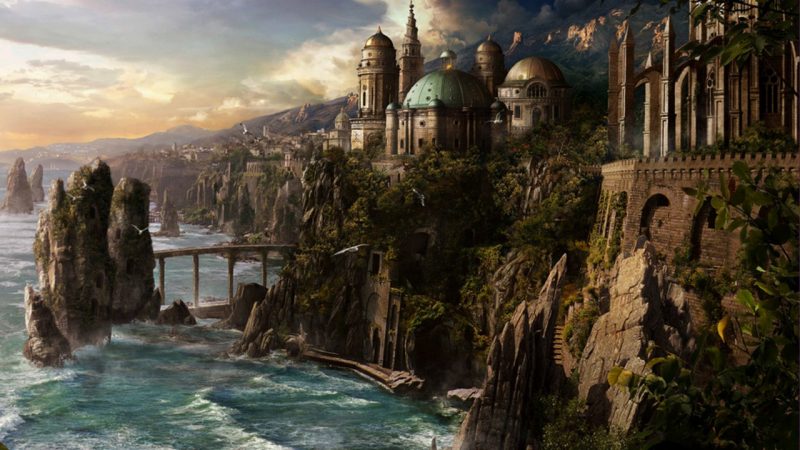 The city states of the Inner Sea are found scattered across the southeast coasts and the nearby islands but the region also includes the Akai Mountains to the east and the Tavir Highlands to the south. The coast is mostly populated by wood elves but is also home to large number of skeyn and some outposts of jungle elves that serve as harbors for ships transporting goods between the Inner Sea and the South. The Akai Mountains are the homeland of the yao who have few large settlements of their own and are mostly hunters and herders in a comperatively barren land. The Tavir Highlands are a desolate place feared by most people as they are prone to earthquakes and covered in small volcanoes and bottomless crevices of which many lead down into the underworld. The Highlands are home to the wilders, primitive and savage people of mixed wood elf and jungle elf ancestry that are said to worship the spirits of the Underworld.
The city states of the Inner Sea are found scattered across the southeast coasts and the nearby islands but the region also includes the Akai Mountains to the east and the Tavir Highlands to the south. The coast is mostly populated by wood elves but is also home to large number of skeyn and some outposts of jungle elves that serve as harbors for ships transporting goods between the Inner Sea and the South. The Akai Mountains are the homeland of the yao who have few large settlements of their own and are mostly hunters and herders in a comperatively barren land. The Tavir Highlands are a desolate place feared by most people as they are prone to earthquakes and covered in small volcanoes and bottomless crevices of which many lead down into the underworld. The Highlands are home to the wilders, primitive and savage people of mixed wood elf and jungle elf ancestry that are said to worship the spirits of the Underworld.
In addition, the Inner Sea is also the primary region of activity for the Sakaya. Originally the Sakaya started as a kind of monastic order that still exists in the Akai Mountains, but whose warriors have increasingly transformed into mercenary bands or raiders that have cut almost all ties with the monasteries. Several Sakaya generals have risen to be among the most powerful warlords of the Inner Sea and become a major threat to many of the established kings. The Inner Sea is also the region with the largest numbers of mortal sorcerers, most of which are nobles from the elven city states and sometimes practice their demonic powers openly.
The Lands of Mist
This region lies in the northwest of the Ancient Lands between the Inner Sea in the south, the ocean in the west, and the arctic sea in the North. Unintentinally, though perhaps subconsciouslty, I’ve been grouping all my ideas for dreary and desolate regions in this part of the map. It kind of satisfies my own appreciation for “that northern thing”, but while it’s certainly highly influenced by Norway and Iceland it’s very much not Viking themed.
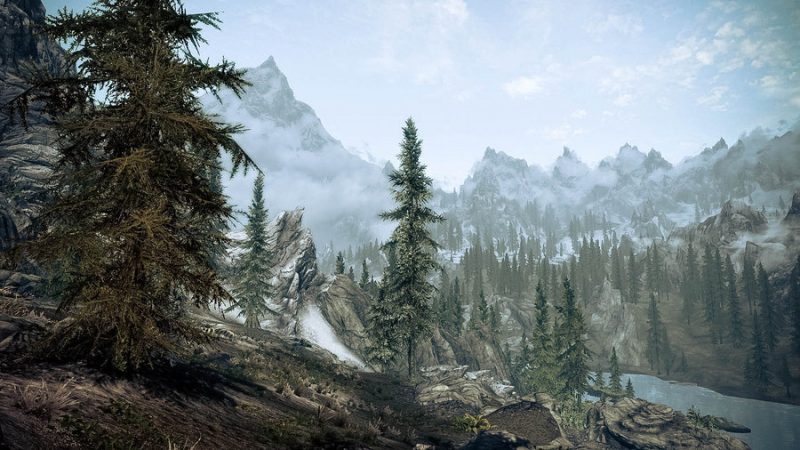 The Lands of Mist all have a subarctic maritime climate, which means cool and damp summers and freezingly cold damp winters. It’s damp pretty much all the time, overcast more often than not, and one of the few places in the Ancient Lands where moors, marshes, or even barren rock are just as common as woodlands. Population here is sparse, even compared to the rest of the world, and those people who settled here did so out of necessity rather than choice. There are some wood elves and kaas living here, as well as some mining outposts of skeyn. But most people are either jungle elves who have eatablished colonies that export dried fish to the south, or the Kaska, a group of savage yao who have fled to this distant corner of the world to flee the wrath of their gods.
The Lands of Mist all have a subarctic maritime climate, which means cool and damp summers and freezingly cold damp winters. It’s damp pretty much all the time, overcast more often than not, and one of the few places in the Ancient Lands where moors, marshes, or even barren rock are just as common as woodlands. Population here is sparse, even compared to the rest of the world, and those people who settled here did so out of necessity rather than choice. There are some wood elves and kaas living here, as well as some mining outposts of skeyn. But most people are either jungle elves who have eatablished colonies that export dried fish to the south, or the Kaska, a group of savage yao who have fled to this distant corner of the world to flee the wrath of their gods.
The Lands of Mist consist of three main regions. The Islands of the coast are home to the jungle elves who have adapted their culture to this harsh environment, particularly in the south where forests are still common. The mainland coast is where most of the wood elves and kaas are living in small fortified villages. Some distance inland lie the Witchfens, a vast soggy wetland that is inhabited only by the Kaska, who occasionally raid the coastal lands.
Even though the region is a remote and inhospitable wilderness now, there are many old ruins around, many of which seem to be almost undisturbed by treasure hunters. The opportunity to find great riches and magical treasures is high but it’s particularly dangerous. The Lands of Mist are designed for darker adventures and suited either for higher level parties or campaigns going for a higher lethality.
The Southern Jungles
The tropical jungles and islands of the south started originally as an idea for providing an origin for the naga and having a great culture of lizardmen. Because it’s a prehistoric fantasy world and you really need to have a dominant race of reptile men. But when I decided to put the focus on a wilderness world I ended up scrapping the idea of a lizardmen empire as the dominant civilization. However, I recently braught the lizardmen back, though now as a more average culture. The islands of the southern sea oviously exist to cover any Island of Dread needs while the mainland goes for a style of the vast jungles of central Africa.
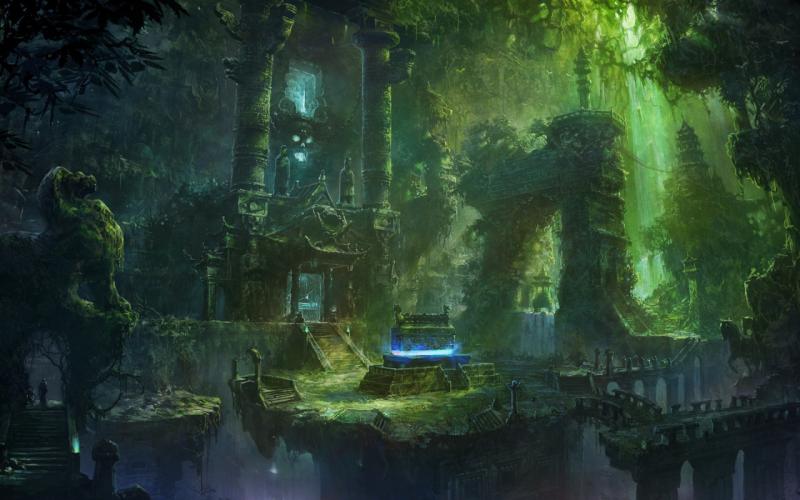 The Southern Jungles lie south of the southernmost parts of the Inner Sea and also include the many islands that lie off the coast to the west and north. Both the mainland and the islands are home to jungle elves and lizardmen but even further south lies the mystical land of Kemesh, which to this very day is under the control of various powerful naga city states. The naga themselves only make up a small portion of the population, which consists almost entirely of elven and lizardmen slaves. The free tribes of both peoples are in an eternal war with the naga, but this has settled into a permanent state of mostly minor skirmishes and raids for many centuries now.
The Southern Jungles lie south of the southernmost parts of the Inner Sea and also include the many islands that lie off the coast to the west and north. Both the mainland and the islands are home to jungle elves and lizardmen but even further south lies the mystical land of Kemesh, which to this very day is under the control of various powerful naga city states. The naga themselves only make up a small portion of the population, which consists almost entirely of elven and lizardmen slaves. The free tribes of both peoples are in an eternal war with the naga, but this has settled into a permanent state of mostly minor skirmishes and raids for many centuries now.
Eldritch Lore: Undead
This is hopefully going to be the first enty in a new series of post. I’ve often been talking about having a pretty much complete monster book for the Ancient Lands lying around that only needs the various monster descriptions typed down but so far I’ve never got around to actually do it. This hopefully is going to change now. There are close to a hundred monsters I’ve created for the Ancient Lands (and probably that many again that ended up cut) and they more or less fall into two basic categories. Supernatural monsters and fictional animals. While I really love my weird animals, there’s not really much interesting to say about them. A hippo with horns is stills just a hippo and a big hadrosaurus that has the stats and behavior of a camel is still just a camel. Not terribly exciting to read, nor to write. For the final document I am probably going to cover them with just two or three sentences each.
That still leaves the spirits, demons, undead, and other magical critters, and those are where all of the real meat is. I am kind of starting this at the very end with the undead, who don’t actually play much of a significant role in the greater design of the setting and which are by far the fewest in number. Though this is what is actually making them the easiest to cover, and I’m always the first to admit that I am really lazy, so here you have them. I admit that there is nothing drastically new or original about them and they are in fact the most mainstream depictions of undead you can get. But I think most undead in fantasy are really just slight modifications of these and since undead are not going to be a real focus of the setting they should be sufficient. Also, given the way that undeath works in the Ancient Lands, having numerous highly specialized forms of undead wouldn’t feel really appropriate.
General Undead Information
Undead are rare and terrifying monsters in the Ancient Lands and only come into being through the effects of sorcery and demonic corruption. There is no single definition of undeath, but all these creatures share in common that they originally used to be living people (or animals) but have been transformed into something neither fully living nor dead. Animated corpses, wights, shades, and wraiths are the remains of people who have unquestionably died and whose spirits are forever gone. With ghouls and darklings things are much less clear as they have never truly died but share many of the other traits common to undead creatures. They might more accurately be described as corrupted rather than undead but this is a distinction that only matters to sages who have never actually encountered them in person.
While ghouls and darklings are still consisting of a unified body and spirit and sustain themselves through consuming the flesh of the living, the other types of undead are fully magical beings that can not exist independently of the source of sorcerous power that created them. Walking corpses are usually close to the sorcerer or demon that created them while wights, shades, and wraiths are eternally linked to the corrupted energies of the place that spawned them. In fact they are more part of the place than separate beings and as such it is impossible to exist beyond its borders. This is widely seen as a blessing as these undead horrors have the ability to turn the slain into more of their own.
Animated Corpse
XP: 20
No. Appearing: 2d4 (4d6)
Armor: 12
Move: 90′
Hit Dice: 2 (9 hp)
Attack: Claw +2 (1d6) or weapon +2 (1d6)
Saving Throws
Paralysis: 14
Poison: 12
Breath: 15
Device: 13
Magic: 16
Morale: 12
Special: Immune to disease, poison, charm, paralysis, and sleep.
Animated corpses are known under many names but in the end they are effectively just that. The remains of living people and beasts that have magically been giving a semblance of life by the magic of a sorcerer or demon. They have no spirit of their own and are nothing more than empty shells made to rise and move pulled by magic strings. While terrifying to look at, animated corpses pose no greater threat than living beasts and can simply be cut down by any blade, but as there is no blood running in their veins they tend to continue fighting until they are hacked to pieces.
Ghouls
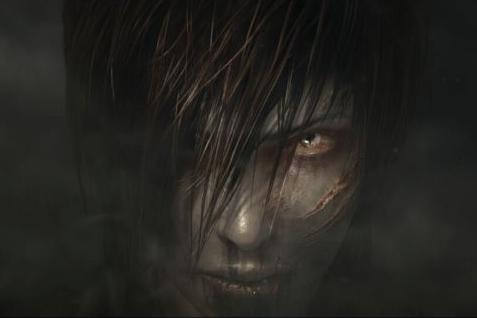 XP: 25
XP: 25
No. Appearing: 1d8 (3d6)
Armor: 14
Move: 120′
Hit Dice: 2 (9 hp)
Attack: Claw +2 (1d4 + paralysis) or weapon +2 (1d6)
Saving Throws:
Paralysis: 14
Poison: 12
Breath: 15
Device: 13
Magic: 16
Morale: 8
Special: Immune to disease, poison, charm, paralysis, and sleep.
Ghouls are elves, yao, or other humanoids who have been corrupted by the dark magic of sorcery or demons. Though they have never truly died, they resemble the undead, existing in a state between life and death. They grow gaunt with pale skin and dark sunken eyes and are suffering from madness, but are also filled with unnatural vigor and are much more cunning than any beast. Their clawed fingers can crush a mans throat and leave deep rends in the flesh of their victims, and their teeth have the strength to bite through bones, as they regain their strength by feeding on the flesh of humans and beasts.
Many ghouls once were adventurers and treasure hunters who delved too deep into ancient places where the living are not meant to tread, or what remains of those who become slaves of dark sorcerers or demons. The corruption that warped their bodies also affects their minds and all of them are clearly unhinged, but most of them seem to retain the memories of their former lives and traces of their past selves.
A living creature hit by a ghoul’s claws must make a saving throw against paralysis or collapse to the ground unable to move for 2d4x10 minutes.
Darklings
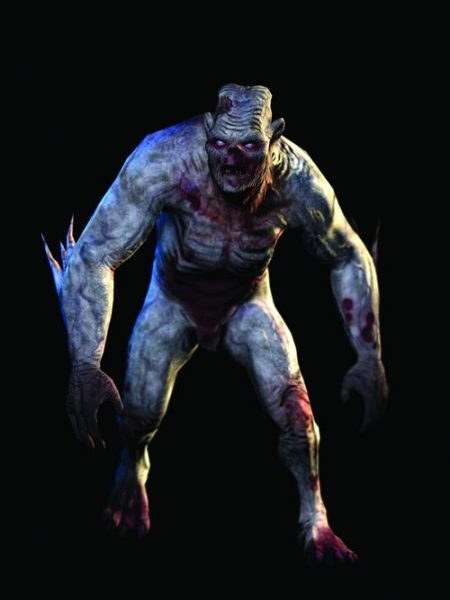 XP: 35
XP: 35
No. Appearing: 1d8 (2d8)
Armor: 14
Move: 120′
Climb: 90′
Hit Dice: 3 (13 hp)
Attack: Claw +3 (1d6 + paralysis)
Saving Throws:
Paralysis: 14
Poison: 12
Breath: 15
Device: 13
Magic: 16
Morale: 10
Special: Immune to disease, poison, charm, paralysis, and sleep.
Darklings are ghouls that not only have survived in their undead state for decades but actually managed to gain additional strength from it, losing their last traces of humanity in the process. While still roughly the size of a person, darklings are are powerfully build beasts with pale gray hide that run on all fours and have become truly feral in their madness. Darklings are almost always found underground and never go outside during the day. Their small black eyes can see perfectly even without any kind of light. They have never be seen to follow commands of other creatures or communicating in an intelligible manner but have been known to be magically goaded by sorcerers to patrol the area around their lairs or attack the strongholds of their enemies in large packs. Continue reading “Eldritch Lore: Undead”

